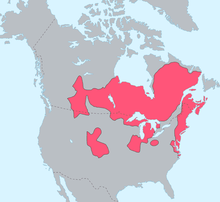Algonquian peoples


The Algonquians are one of the most populous and widespread
Before Europeans came into contact, most Algonquian settlements lived by hunting and fishing, although many of them supplemented their diet by cultivating corn, beans and squash (the "Three Sisters"). The Ojibwe cultivated wild rice.[3]
Colonial period
At the time of the first European settlements in
Tribal identity
The Algonquian peoples include and have included historical populations in:
- Narragansett of Rhode Island, United States
- Mohegan of Connecticut, United States
- Chowanoke, formerly of North Carolina
- Carolina Algonquian
- Roanoke, formerly of North Carolina
- Croatan, formerly of North Carolina
- Powhatan Confederacy of Virginia
- Pamunkey of Virginia, United States
- Powhatan people of Virginia, United States
- Wampanoag of Massachusetts
-
- Abenaki of Quebec, Canada; historically New Hampshire, Maine and Vermont.
- Penobscot of Maine
- Newfoundland
- Passamaquoddy of Maine, United States, and New Brunswick, Canada.
- Maliseet of New Brunswick and Quebec
- Ohio River Valley, now Oklahoma
- Central Algonquianpeoples
- Kickapoo (Kikapú, Kiikaapoa, Kiikaapoi): originally from southeast Michigan and Wisconsin United States; now in Kansas, Oklahoma, and Texas, United States; Coahuila, Mexico
- Anishinaabe, Great Lakes, Subarctic, Northern Plains
- Ojibwe (including the Saulteaux and Oji-Cree)), Minnesota, North Dakota, and Michigan, United States, as well as Ontario, Canada
- Potawatomi of Michigan, Indiana, Kansas, Oklahoma, United States; Ontario, Canada
- Odawa of Michigan and now Oklahoma, United States; Ontario, Canada
- Mississaugas of Ontario, Canada
- Nipissing of Ontario, Canada.
- Algonquin of Ontario and Quebec, Canada
- Cree of Alberta, Manitoba, Ontario, Saskatchewan, and the Northwest Territories, Canada, as well as Montana, United States.
New England area
Colonists in the Massachusetts Bay area first encountered the
The Algonquians of
In warm weather, they constructed portable
In the spring, when the fish were spawning, they left the winter camps to build villages at coastal locations and waterfalls. In March, they caught
From April through October, natives hunted
In December, when the snows began, the people created larger winter camps in sheltered locations, where they built or reconstructed longhouses. February and March were lean times. The tribes in
The southern Algonquians of New England relied predominantly on
Scholars estimate that, by the year 1600, the indigenous population of New England had reached 70,000–100,000.[14]
Midwest
The French encountered Algonquian peoples in this area through their trade and limited colonization of New France along the Mississippi and Ohio rivers. The historic peoples of the Illinois Country were the
During the nineteenth century, many Native Americans from east of the Mississippi River were displaced over great distances through the United States passage and enforcement of Indian removal legislation; they forced the people west of the Mississippi River to what they designated as Indian Territory. After the US extinguished Indian land claims, this area was admitted as the state of Oklahoma in the early 20th century.[15]
Upper west
Ojibwe/Chippewa,
List of historic Algonquian-speaking peoples
- Algonquin
- Abenaki
- Arapaho
- Beothuk
- Blackfoot
- Cheyenne
- Chowanoke
- Cree
- Gros Ventre
- Illinois
- Kickapoo
- Lenape
- Meskwaki
- Menominee
- Mahican
- Maliseet
- Mascouten
- Massachusett
- Mattabesic
- Miami
- Mi'kmaq
- Montaukett
- Mohegan
- Nanticoke
- Narragansett
- Niantic
- Nipissing
- Nipmuc
- Odawa
- Ojibwe
- Passamaquoddy
- Penobscot
- Pequot
- Potawatomi
- Powhatan
- Sauk
- Shawnee
- Secotan
- Wampanoag
- Weapemeoc
- Plains Cree
See also
- Doctors Dean R. Snow and William A. Starna -- Archeologists and historians who have conducted ground-breaking archeological research in the Mohawk Valley and other Algonquian and Iroquoian sites.
Footnotes
- ^ "The towne of Pmeiock", Encyclopedia Virginia
- ISSN 0048-0738.
- S2CID 55940408.
- ^ "Algonquin Indians". AAA Native Arts. Retrieved 2020-04-14.
- ^ Mark Kurlansky, 2006 [page needed]
- ^ Dreibelbis, 1978 , page 33
- ^ "Algonquian peoples". www.know.cf. Retrieved 2020-04-14.[permanent dead link]
- ^ Stevenson W. Fletcher, Pennsylvania Agriculture and Country Life 1640-1840 (Harrisburg: Pennsylvania Historical and Museum Commission, 1950), 2, 35-37, 63-65, 124.
- JSTOR 1930900.
- ^ New England and New York areas 1580-1800, 1953. Note: The Lenni Lenape (Delaware) in New Jersey and the Massachuset in Massachusetts used fire in ecosystems
- ^ Russell, Emily W.B. Vegetational Change in Northern New Jersey Since 1500 A.D.: A Palynological, Vegetational and Historical Synthesis, Ph.D. dissertation. New Brunswick, PA: Rutgers University. Author notes on page 8 that Indians often augmented lightning fires. 1979
- JSTOR 1937331. Author found no strong evidence that Indians purposely burned large areas, but they did burn small areas near their habitation sites. Noted that the Lenna Lenape used fire.
- ^ Gowans, William. "A Brief Description of New York, Formerly Called New Netherland with the Places Thereunto Adjoining, Likewise a Brief Relation of the Customs of the Indians There." New York, NY: 1670. Reprinted in 1937 by the Facsimile Text Society, Columbia University Press, New York. Notes that the Lenni Lenape (Delaware) in New Jersey used fire in ecosystems.
- ^ ISBN 978-0-8090-0158-3.
- ^ a b "History | Meskwaki Nation". Archived from the original on 2020-04-12. Retrieved 2020-04-14.
- ^ "Ojibwe". www.tolatsga.org. Retrieved 2020-04-14.
Further reading
- Melissa Otis, Rural Indigenousness: A History of Iroquoian and Algonquian Peoples of the Adirondacks. Syracuse, NY: Syracuse University Press, 2018.
External links
 Media related to Algonquian peoples at Wikimedia Commons
Media related to Algonquian peoples at Wikimedia Commons
